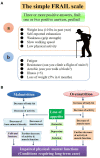Herbal Medicine Ninjin'yoeito in the Treatment of Sarcopenia and Frailty
- PMID: 30619872
- PMCID: PMC6299011
- DOI: 10.3389/fnut.2018.00126
Herbal Medicine Ninjin'yoeito in the Treatment of Sarcopenia and Frailty
Abstract
Frailty and sarcopenia have recently gained considerable attention in terms of preventive care in Japan, which has an ever-increasing aging population. Sarcopenia is defined as atrophy of skeletal muscles caused by the age-related decrease in growth hormone/insulin-like growth factor and sex hormones. The Japanese Ministry of Health, Labor and Welfare reports that frailty can lead to impairment of both mental and physical functioning. Chronic diseases such as diabetes and dementia may underlie frailty. It is important to prevent progression of frailty and extend the healthy lifespan. In herbal medicine practice, including Japanese Kampo medicine, "Mibyo," a presymptomatic state, has long been recognized and may be applicable to frailty. Kampo medicines may include several medicinal plants and are thought to have the potential to improve symptoms of frailty, such as loss of appetite and body weight, fatigue, and sarcopenia, as well as anxiety, depression, and cognitive decline. Ninjin'yoeito (Ren Shen Yang Ying Tang) is the most powerful Kampo medicine and has been widely applied to palliative care of cancer patients. This review includes recent anti-aging studies and describes the effects and mechanisms of Ninjin'yoeito (Ren Shen Yang Ying Tang) when used for frailty or to extend a healthy life expectancy.
Keywords: aging; appetite loss; frailty; ghrelin-neuropeptide Y signals; herbal medicine; kampo medicine; ninjin'yoeito; sarcopenia.
Figures


References
-
- Inui A. Frailty and Ninjin'yoeito. Phil Kampo (2016) 58:30–3. (in Japanese).
-
- Sameshima N, Sakaki M, Ishigami M, Morinaga M, Amitani M, Inui A. Frailty and Ninjin-yoei-to. Anti. Aging. Med. (2017) 13:52–60. (in Japanese).
Publication types
LinkOut - more resources
Full Text Sources

